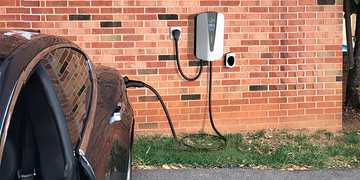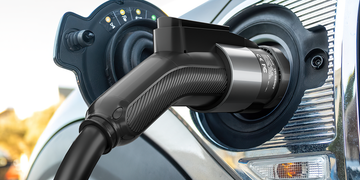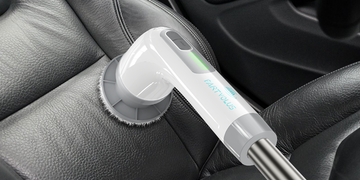Can you charge an EV with a wall charger? All mass-produced electric vehicles today include a 110-volt-compatible (Level 1) charging unit which is able to be plugged into any standard 110v household outlet. The downside of EV charging with a 110v outlet is that it takes a while.
However, others with long commutes or who drive for work need more range may prefer to invest in a 240v, Level 2 wall-mounted charger. 240 outlets are the type you typically see for electric clothes dryers at home and are the type most commonly installed for public charging stations. Compared with Level 1 charging, a Level 2 charge takes about half the time - providing about 180 miles of range over an eight-hour overnight charging period. Level 2 charging is the best option for drivers in a hurry as well as those who drive more miles in a day. Level 2 fast charging is especially attractive for those who don’t have reliable access to public or workplace chargers. A Level 2 Charger will need to be installed with the help of an electrician and it can be placed in a location that makes at-home charging even easier.
Charging an electric vehicle (EV) with a wall charger is a common and convenient way to replenish your vehicle's battery. Wall chargers, also known as Electric Vehicle Service Equipment (EVSE) or home chargers, are installed at homes or businesses and provide a dedicated and faster charging option compared to a standard wall outlet.
Here's a basic guide on how to charge an EV with a wall charger:
Install a Home Charger:
Start by installing a home wall charger. This typically involves hiring a qualified electrician to set up the charging station in a location that's easily accessible for your electric vehicle.
Plug In the Charger:
Once the home charger is installed, plug the charging cable into your electric car's charging port. Make sure the connection is secure.
Power On the Charger:
Some chargers may have a power switch or button. Ensure that the charger is turned on and ready to supply electricity to your electric car.
Activate Charging on Your EV:
Depending on your electric car model, you might need to activate the charging process manually. This could involve pressing a button on the dashboard or using a mobile app.
Monitor Charging Progress:
Keep an eye on your electric car's charging progress through the vehicle's display or the charging station's indicator lights. Charging times vary based on the charger's power level and your car's battery capacity.
Stop Charging and Disconnect:
When your electric car is fully charged or when you're ready to stop charging, deactivate the charging process through your vehicle's controls. Then, safely disconnect the charging cable from both the car and the charging station.
Choosing the Right Home Charger
With so many EV chargers on the market, it is important to know what to look for. Here are a few factors to consider:
Hardwire/Plug-in: Whilemany charging stations need to be hardwired and cannot be moved, some modern models plug into the wall for additional portability. However, these models may still need a 240-volt outlet for operation.
Length of cable: If the chosen model is not portable, it is important to make sure the car charger is mounted in a place that enables it to reach the electric vehicle port. Be mindful that other EVs maybe need to be charged with this station in the future , so make certain there’s some flexibility.
Size: Because garages are often tight on space, seek an EV charger that is narrow and offers a snug fit to minimize the intrusion of space from the system.
Weatherproof: If the home charging station is being used outside of the garage, search for a model that is rated for use in the weather.
Storage: It is important not to leave the cable hanging loosely while it’s not in use. Try to find a home charger with a holster that holds everything in place.
Ease of use: Be mindful to choose a model that is easy to use. There is no reason not to have a charging station with a smooth operation to get the car plugged in and disconnected.
Features: There are charging stations that allow the scheduling charging operation for times when electricity is cheaper. Some models can also be set up to resume charging automatically when the power comes back on should an outage occur. In some cases, charging station operations can be synced through a smartphone app.

Telgeoot Level 2 EV Charging Station
· Electric Car Charger EVSE SAE J1772, NEMA 14-50 Plug
· Up to 44 mi of range added per hour at 11KW / 48 amp output
· Auto-sensing handle to open charge port
· Monitor and manage your charging schedule and usage from the Tesla app
· Wi-Fi connectivity for over-the-air updates, remote diagnostics and access controls
· Versatile indoor / outdoor design
· Variable amperage configurations depending on installation location
· Power-share with up to six Wall Connectors
· 20-foot cable length
· One-year warranty for residential use
Can you charge an EV with a wall charger? Yes, Telgeoot Level 2 EV charging can be wall mounted and is very easy to install. Telgeoot Level 2 EV Charging Station has been equipped with multiple safety protections, Over Voltage protection, Overload protection, Short Circuit protection, Ground protection, Earth Leakage protection. This ev charging station unit can operate in environments of -30℃ to 55℃ (-22°F to 131°F). The connector operating life is up to 10000 times. Allows to adjust charging current range from 1 to 48A, level 2 EV 240V 11kw home charger can work 7X faster than a normal Level 1 chargers, Say goodbye to long charging times.





